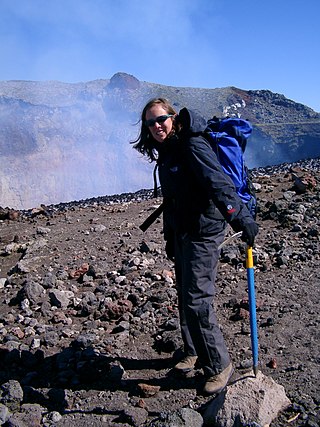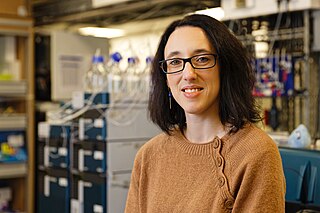
Aerobiology is a branch of biology that studies the passive transport of organic particles, such as bacteria, fungal spores, very small insects, pollen grains and viruses. Aerobiologists have traditionally been involved in the measurement and reporting of airborne pollen and fungal spores as a service to those with allergies. However, aerobiology is a varied field, relating to environmental science, plant science, meteorology, phenology, and climate change.
Isoprene, or 2-methyl-1,3-butadiene, is a common volatile organic compound with the formula CH2=C(CH3)−CH=CH2. In its pure form it is a colorless volatile liquid. It is produced by many plants and animals (including humans) and its polymers are the main component of natural rubber. C. G. Williams named the compound in 1860 after obtaining it from the pyrolysis of natural rubber; he correctly deduced the empirical formula C5H8.

Indoor air quality (IAQ) is the air quality within buildings and structures. Poor indoor air quality due to indoor air pollution is known to affect the health, comfort, and well-being of building occupants. It has also been linked to sick building syndrome, respiratory issues, reduced productivity, and impaired learning in schools. Common pollutants of indoor air include: secondhand tobacco smoke, air pollutants from indoor combustion, radon, molds and other allergens, carbon monoxide, volatile organic compounds, legionella and other bacteria, asbestos fibers, carbon dioxide, ozone and particulates.

A polycyclic aromatic hydrocarbon (PAH) is a class of organic compounds that is composed of multiple aromatic rings. The simplest representative is naphthalene, having two aromatic rings, and the three-ring compounds anthracene and phenanthrene. PAHs are uncharged, non-polar and planar. Many are colorless. Many of them are found in coal and in oil deposits, and are also produced by the incomplete combustion of organic matter—for example, in engines and incinerators or when biomass burns in forest fires.
Volatile organic compounds (VOCs) are organic compounds that have a high vapor pressure at room temperature. High vapor pressure correlates with a low boiling point, which relates to the number of the sample's molecules in the surrounding air, a trait known as volatility.
Air stagnation is a meteorological condition that occurs when there is a lack of atmospheric movement, leading to the accumulation of pollutants and particles that can decline the air quality in a particular region. This condition typically correlates with air pollution and poor air quality due to the possible health risks it can cause to humans and the environment. Due to light winds and lack of precipitation, pollutants cannot be cleared from the air, either gaseous or particulate.

Mark Zachary Jacobson is a professor of civil and environmental engineering at Stanford University and director of its Atmosphere/Energy Program. He is also a co-founder of the non-profit, Solutions Project.

Roger Arthur Sheldon is a British chemist who is emeritus professor of Biocatalysis and Organic Chemistry at Delft University of Technology in the Netherlands.

James Robert DurrantFRSC FLSW is a British photochemist. He is a professor of photochemistry at Imperial College London and Sêr Cymru Solar Professor at Swansea University. He serves as director of the centre for plastic electronics (CPE).
Lucy Jane Carpenter is professor of physical chemistry at the University of York and director of the Cape Verde Atmospheric Observatory (CVAO).

Tamsin Alice Mather is a British Professor of Earth Sciences at the Department of Earth Sciences, University of Oxford and a Fellow of University College, Oxford. She studies volcanic processes and their impacts on the Earth's environment and has appeared on the television and radio.
Kimberly A. Prather is an American atmospheric chemist. She is a distinguished chair in atmospheric chemistry and a distinguished professor at the Scripps Institution of Oceanography and department of chemistry and biochemistry at UC San Diego. Her work focuses on how humans are influencing the atmosphere and climate. In 2019, she was elected a member of the National Academy of Engineering for technologies that transformed understanding of aerosols and their impacts on air quality, climate, and human health. In 2020, she was elected as a member of the National Academy of Sciences. She is also an elected Fellow of the American Philosophical Society, American Geophysical Union, the American Association for the Advancement of Science, American Philosophical Society, and the American Academy of Arts and Sciences.
Barbara Ann Maher is a Professor Emerita of Environmental Science at Lancaster University. She served as director of the Centre for Environmental magnetism & Palaeomagnetism until 2021 and works on magnetic nanoparticles and pollution.
Jennifer G. Murphy is a Canadian environmental chemist and an associate professor at the University of Toronto. She is known for her research how air pollutants such as increased reactive nitrogen affect the global climate.

Nadine Unger is a Professor of Atmospheric Chemistry at the University of Exeter. She has studied the role of human activities and forests on the Earth's climate.

Saharan dust is an aeolian mineral dust from the Sahara, the largest hot desert in the world. The desert spans just over 9 million square kilometers, from the Atlantic Ocean to the Red Sea, from the Mediterranean Sea to the Niger River valley and the Sudan region in the south.
Non-exhaust emissions come from wearing down motor vehicle brake pads, tires, roads themselves, and unsettling of particles on the road. This particulate matter is made up of micrometre-sized particles and causes negative health effects, including respiratory disease and cancer. Very fine particulate matter has been linked to cardiovascular disease. Multiple epidemiological studies have demonstrated that particulate matter exposure is associated with acute respiratory infections, lung cancer, and chronic respiratory and cardiovascular disease. Researchers have also found correlations between exposure to fine particulate matter and fatality rates in previous coronavirus epidemics.
David Fowler,, is a British environmental physicist, recognized as an authority on atmospheric pollution. He specializes in micrometeorology, the land-atmosphere exchange of trace gases and particles, and the effects of pollutants on vegetation.
Colin Dermot O'Dowd is an Irish physicist and atmospheric scientist.

Chiara Giorio is an Italian atmospheric chemist who is an Assistant Professor in the Yusuf Hamied Department of Chemistry at the University of Cambridge, a Fellow of Christ's College and a Fellow of the Community for Analytical Measurement Science.










